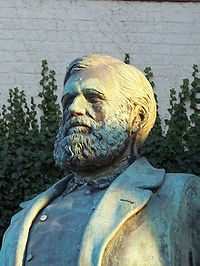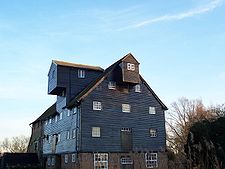
Potto Brown
Encyclopedia

Miller
A miller usually refers to a person who operates a mill, a machine to grind a cereal crop to make flour. Milling is among the oldest of human occupations. "Miller", "Milne" and other variants are common surnames, as are their equivalents in other languages around the world...
and nonconformist
Nonconformism
Nonconformity is the refusal to "conform" to, or follow, the governance and usages of the Church of England by the Protestant Christians of England and Wales.- Origins and use:...
philanthropist
Philanthropist
A philanthropist is someone who engages in philanthropy; that is, someone who donates his or her time, money, and/or reputation to charitable causes...
in Huntingdonshire
Huntingdonshire
Huntingdonshire is a local government district of Cambridgeshire, covering the area around Huntingdon. Traditionally it is a county in its own right...
, England
England
England is a country that is part of the United Kingdom. It shares land borders with Scotland to the north and Wales to the west; the Irish Sea is to the north west, the Celtic Sea to the south west, with the North Sea to the east and the English Channel to the south separating it from continental...
. He is commemorated by a statue in the village of Houghton
Houghton, Cambridgeshire
Houghton is a village in the English county of Cambridgeshire. Prior to 1974, it was part of the former county of Huntingdonshire. The village is in the civil parish of Houghton and Wyton and is situated between Huntingdon and St Ives on the A1123 road, and not far south of RAF Wyton...
where he was born, lived and died. Local schools and churches are a monument to his philanthropy.
Early life
Brown was born into a prominent QuakerReligious Society of Friends
The Religious Society of Friends, or Friends Church, is a Christian movement which stresses the doctrine of the priesthood of all believers. Members are known as Friends, or popularly as Quakers. It is made of independent organisations, which have split from one another due to doctrinal differences...
family. He was the fourth of 12 children of William Brown and Elizabeth Hicks and was named after his paternal grandmother, Sarah Potto. Brown’s father was a baker and miller in Earith
Earith
Earith is a village in the Fens of Cambridgeshire, England, south of Chatteris and east of Huntingdon. At Earith, two artificial diversion channels of the River Great Ouse, the Old Bedford River and the New Bedford River, leave the river on a course to Denver Sluice near Downham Market, where they...
, moving to Houghton to run Houghton Mill
Houghton Mill
Houghton Mill is a water mill located on the Great Ouse in Houghton, Cambridgeshire, England. It is a National Trust property.-History:Various mills have occupied this spot since the first building was erected in the year 969. In the Middle Ages, the mill was owned by the nearby Benedictine Abbey,...
on the River Ouse
River Great Ouse
The Great Ouse is a river in the east of England. At long, it is the fourth-longest river in the United Kingdom. The river has been important for navigation, and for draining the low-lying region through which it flows. Its course has been modified several times, with the first recorded being in...
.
Brown was educated at Huntingdon Grammar School and Slepe Hall in St Ives
St Ives, Cambridgeshire
St Ives is a market town in Cambridgeshire, England, around north-west of the city of Cambridge and north of London. It lies within the historic county boundaries of Huntingdonshire.-History:...
, a school for about 75 boys many of whom came from dissenting families. He did not excel academically. "That which is conventionally called education left strangely few traces upon him." It was at Slepe Hall that Brown met his future business partner Joseph Goodman.
Upon leaving school Brown, together with Goodman, started work in his father’s mill. They took over the running of the mill in 1821 when William Brown retired. After his retirement William Brown took up medicine, attending lectures and hospital rounds in London and then becoming apprenticed to a local surgeon and apothecary, George Cockle.
Marriage
In 1822 Brown married fellow Quaker Mary Bateman. They had several children of whom only two survived infancy. Bateman and George Brown followed their father into milling. Bateman Brown became mayor of St Ives, only the second nonconformist to hold the position since the time of Oliver Cromwell. One of Brown’s grandsons became the fourth generation of the family to run the mill at Houghton. A granddaughter married the artist Charles Whymper. A greatgrandson, Bateman Brown Tarring, won the London amateur 1-mile speed skating championship in December 1892.Brown was widowed in 1854, remarried and was widowed again. He married for the third time in 1869.
Milling

Flour
Flour is a powder which is made by grinding cereal grains, other seeds or roots . It is the main ingredient of bread, which is a staple food for many cultures, making the availability of adequate supplies of flour a major economic and political issue at various times throughout history...
whose reputation was well known in London. Brown worked on the principle that the best flour came from a combination of careful blending of wheat and the use of the best milling machinery. Known as a "slow grinder", he spared no expense on his millstones. Having established a friendship with the French miller Auguste-Rodolphe Darblay, Brown adopted the French millstone ventilation system and the French method of dressing millstones with black diamonds.
With the help of his sons and one of Goodman’s sons (Goodman having died in 1844) Brown expanded the business by building steam mills at St Ives (1854) and Godmanchester (1861). Both mills employed the latest French milling technology. He retired from the business in 1862 and spent the remaining years of his life on farming, philanthropic activities, and work as a magistrate.
"The village philanthropist"

Congregational church
Congregational churches are Protestant Christian churches practicing Congregationalist church governance, in which each congregation independently and autonomously runs its own affairs....
. Tolerant of other denominations, he welcomed into his home French Catholics and American Protestants alike. Visitors included the revivalist Charles Grandison Finney
Charles Grandison Finney
Charles Grandison Finney was a leader in the Second Great Awakening. He has been called The Father of Modern Revivalism. Finney was best known as an innovative revivalist, an opponent of Old School Presbyterian theology, an advocate of Christian perfectionism, a pioneer in social reforms in favor...
and the peace and anti-slavery activist Elihu Burritt
Elihu Burritt
Elihu Burritt was an American philanthropist and social activist.-Biography:He was born December 8, 1810, in the town of New Britain, Connecticut....
. Although a supporter of the temperance movement he offered wine or beer to guests over the age of sixty.
In 1840 Brown and Goodman founded the chapel in Houghton, which previously had no place for nonconformist worship. A minister was employed to preach in Houghton and neighbouring villages. They also set up British schools (schools not associated with the Church of England) in Houghton and St Ives. Two decades later Brown donated £3,000 to build the Free Church in St Ives, a centre of worship for the union of Baptists and Independents of St Ives and the Congregationalists of surrounding villages. Brown also donated £1,000 towards the cost of Huntingdon Free Church.
Brown helped run the St Ives Friendly Society and provided allotments for the inhabitants of St Ives, Warboys
Warboys
Warboys is a village in Huntingdonshire , England, near Ramsey and north east of Huntingdon.-History:Warboys is a large parish and village on what was the eastern side of Huntingdonshire bordering on Cambridgeshire. It was returned in the Domesday survey of 1086 amongst the lands of St...
and Houghton. He also organised an annual temperance fete as a rival to the Houghton Feast (an attempt to establish a "respectable dancing booth" at the feast having failed), and was a supporter of the Lifeboat Society.
The statue
In 1878, seven years after his death, a monument to Brown was unveiled in Houghton. The monument consists of a bronze bust on a pedestal of polished red Aberdeen granite. It was produced in Lucchesi’s studio in London and was based on a model by Albert Goodman, a son of Brown’s milling partner. The inscription reads: "Potto Brown was born in this village 16 July 1797 where he spent his life devoting himself to the best interests of those around him and died 12 April 1871."External links
- Charles G Finney's autobiography. Charles G Finney recalls a visit to Houghton.

